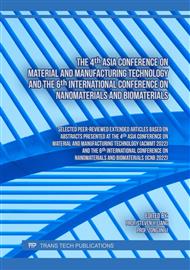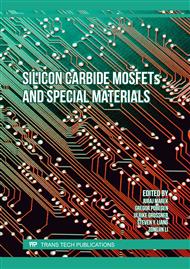[1]
Mandikos M N, McGivney G P, Davis E, Bush P J and Carter J M 2001 A comparison of the wear resistance and hardness of indirect composite resins J. Prosthet. Dent. vol 85 no 4 p.386–395
DOI: 10.1067/mpr.2001.114267
Google Scholar
[2]
Ahmadijokani F, Alaei Y, Shojaei A, Arjmand M and Yan N 2019 Frictional behavior of resin-based brake composites: Effect of carbon fibre reinforcement Wear vol 420–421 p.108–115
DOI: 10.1016/j.wear.2018.12.098
Google Scholar
[3]
Lin L and Schlarb A K 2019 Recycled carbon fibers as reinforcements for hybrid PEEK composites with excellent friction and wear performance Wear vol 432–433
DOI: 10.1016/j.wear.2019.202928
Google Scholar
[4]
Battegazzore D, Frache A, Abt T and Maspoch M L 2018 Epoxy coupling agent for PLA and PHB copolymer-based cotton fabric bio-composites Compos. Part B Eng. vol 148 p.188–197
DOI: 10.1016/j.compositesb.2018.04.055
Google Scholar
[5]
Yan L, Kasal B and Huang L 2016 A review of recent research on the use of cellulosic fibres, their fibre fabric reinforced cementitious, geo-polymer and polymer composites in civil engineering Compos. Part B Eng. vol 92 p.94–132
DOI: 10.1016/j.compositesb.2016.02.002
Google Scholar
[6]
Valášek P, Ruggiero A and Müller M 2017 Experimental description of strength and tribological characteristic of EFB oil palm fibres/epoxy composites with technologically undemanding preparation Compos. Part B Eng. vol 122 p.79–88
DOI: 10.1016/j.compositesb.2017.04.014
Google Scholar
[7]
Yan L, Chouw N and Jayaraman K 2014 Flax fibre and its composites - A review Compos. Part B Eng. vol 56 p.296–317
DOI: 10.1016/j.compositesb.2013.08.014
Google Scholar
[8]
Poole A J, Church J S and Huson M G 2009 Environmentally Sustainable Fibers from Regenerated Protein Biomacromolecules vol 10 no 1 p.1–8
DOI: 10.1021/bm8010648
Google Scholar
[9]
Otto G P et al. 2017 Mechanical properties of a polyurethane hybrid composite with natural lignocellulosic fibers Compos. Part B Eng. vol 110 p.459–465
Google Scholar
[10]
Ranjan Pani P, Nayak R K, Routara B C and Sekhar P C 2019 Flexural and Specific Wear Rate of Seawater Aged Bamboo, Jute and Glass Fiber Reinforced Polymer Hybrid Composites Mater. Today Proc. vol 18 p.3409–3414
DOI: 10.1016/j.matpr.2019.07.268
Google Scholar
[11]
Liu Y, Xie J, Wu N, Wang L, Ma Y and Tong J 2019 Influence of silane treatment on the mechanical, tribological and morphological properties of corn stalk fiber reinforced polymer composites Tribol. Int. vol 131 p.398–405
DOI: 10.1016/j.triboint.2018.11.004
Google Scholar
[12]
Suthan R, Jayakumar V and Bharathiraja G 2019 Wear analysis of bio-fillers reinforced epoxy composites Mater. Today Proc.
DOI: 10.1016/j.matpr.2019.10.154
Google Scholar
[13]
Joseph S, Sreekala M S, Oommen Z, Koshy P and Thomas S 2002 A comparison of the mechanical properties of phenol formaldehyde composites reinforced with banana fibres and glass fibres Compos. Sci. Technol. vol 62 no 14 p.1857–1868
DOI: 10.1016/s0266-3538(02)00098-2
Google Scholar
[14]
Kumar S, Kumar Y, Gangil B and Kumar Patel V 2017 Effects of Agro-Waste and Bio-Particulate Fillers on Mechanical and Wear Properties of Sisal Fibre Based Polymer Composites Mater. Today Proc. vol 4 no 9 p.10144–10147
DOI: 10.1016/j.matpr.2017.06.337
Google Scholar
[15]
Müller M et al. 2019 Material Utilization of Cotton Post-Harvest Line Residues in Polymeric Composites Polymers vol 11 no 7 p.1106
DOI: 10.3390/polym11071106
Google Scholar
[16]
Müller M, Kolář V and Valášek P 2019 Effect of Waterjet Machining Parameters on Cut Quality of Polymeric Composite Materials Based on Biological Reinforcement in Form of Cotton Post-harvest Line Residues Manuf. Technol. vol 19 no 4 p.647–654
DOI: 10.21062/ujep/349.2019/a/1213-2489/mt/19/4/647
Google Scholar
[17]
Ruggiero A, Valášek P, Müller M and D'Amato R 2019 Tribological investigation of epoxy/seed particle composite obtained from residues of processing Jatropha Curcas L. fruits Compos. Part B Eng. vol 167 p.654–667
DOI: 10.1016/j.compositesb.2019.03.041
Google Scholar



